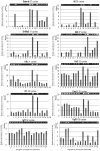PACAP38 differentially effects genes and CRMP2 protein expression in ischemic core and penumbra regions of permanent middle cerebral artery occlusion model mice brain
- PMID: 25257527
- PMCID: PMC4200817
- DOI: 10.3390/ijms150917014
PACAP38 differentially effects genes and CRMP2 protein expression in ischemic core and penumbra regions of permanent middle cerebral artery occlusion model mice brain
Abstract
Pituitary adenylate-cyclase activating polypeptide (PACAP) has neuroprotective and axonal guidance functions, but the mechanisms behind such actions remain unclear. Previously we examined effects of PACAP (PACAP38, 1 pmol) injection intracerebroventrically in a mouse model of permanent middle cerebral artery occlusion (PMCAO) along with control saline (0.9% NaCl) injection. Transcriptomic and proteomic approaches using ischemic (ipsilateral) brain hemisphere revealed differentially regulated genes and proteins by PACAP38 at 6 and 24 h post-treatment. However, as the ischemic hemisphere consisted of infarct core, penumbra, and non-ischemic regions, specificity of expression and localization of these identified molecular factors remained incomplete. This led us to devise a new experimental strategy wherein, ischemic core and penumbra were carefully sampled and compared to the corresponding contralateral (healthy) core and penumbra regions at 6 and 24 h post PACAP38 or saline injections. Both reverse transcription-polymerase chain reaction (RT-PCR) and Western blotting were used to examine targeted gene expressions and the collapsin response mediator protein 2 (CRMP2) protein profiles, respectively. Clear differences in expression of genes and CRMP2 protein abundance and degradation product/short isoform was observed between ischemic core and penumbra and also compared to the contralateral healthy tissues after PACAP38 or saline treatment. Results indicate the importance of region-specific analyses to further identify, localize and functionally analyse target molecular factors for clarifying the neuroprotective function of PACAP38.
Figures





Similar articles
-
Unraveling the Specific Ischemic Core and Penumbra Transcriptome in the Permanent Middle Cerebral Artery Occlusion Mouse Model Brain Treated with the Neuropeptide PACAP38.Microarrays (Basel). 2015 Jan 21;4(1):2-24. doi: 10.3390/microarrays4010002. Microarrays (Basel). 2015. PMID: 27600210 Free PMC article.
-
Transcriptomics and proteomics analyses of the PACAP38 influenced ischemic brain in permanent middle cerebral artery occlusion model mice.J Neuroinflammation. 2012 Nov 23;9:256. doi: 10.1186/1742-2094-9-256. J Neuroinflammation. 2012. PMID: 23176072 Free PMC article.
-
Multimodal neuroprotection induced by PACAP38 in oxygen-glucose deprivation and middle cerebral artery occlusion stroke models.J Mol Neurosci. 2012 Nov;48(3):526-40. doi: 10.1007/s12031-012-9818-1. Epub 2012 Jun 8. J Mol Neurosci. 2012. PMID: 22678884 Free PMC article.
-
Molecular Mechanism for PACAP 38-Induced Neurite Outgrowth in PC12 Cells.Neural Plast. 2021 Aug 7;2021:2522454. doi: 10.1155/2021/2522454. eCollection 2021. Neural Plast. 2021. PMID: 34422037 Free PMC article.
-
Two-color Dye-swap DNA Microarray approach toward confident gene expression profiling in PMCAO mouse model for ischemia-related and PACAP38-influenced genes.Genom Data. 2015 Jan 22;3:148-54. doi: 10.1016/j.gdata.2015.01.007. eCollection 2015 Mar. Genom Data. 2015. PMID: 26484166 Free PMC article.
Cited by
-
Attenuating NF-κB/VCAM-1 Expression in the Middle Cerebral Artery Occlusion Model by Viola Odorata: Protection Against Ischemia-Reperfusion Injury in Rats.Basic Clin Neurosci. 2022 May-Jun;13(3):357-371. doi: 10.32598/bcn.12.6.2061.1. Epub 2022 May 1. Basic Clin Neurosci. 2022. PMID: 36457883 Free PMC article.
-
A systematic review and in silico analysis of studies investigating the ischemic penumbra proteome in animal models of experimental stroke.J Cereb Blood Flow Metab. 2024 Oct;44(10):1709-1722. doi: 10.1177/0271678X241248502. Epub 2024 Apr 19. J Cereb Blood Flow Metab. 2024. PMID: 38639008 Free PMC article.
-
OMICS Analyses Unraveling Related Gene and Protein-Driven Molecular Mechanisms Underlying PACAP 38-Induced Neurite Outgrowth in PC12 Cells.Int J Mol Sci. 2023 Feb 20;24(4):4169. doi: 10.3390/ijms24044169. Int J Mol Sci. 2023. PMID: 36835581 Free PMC article.
-
Unraveling the Specific Ischemic Core and Penumbra Transcriptome in the Permanent Middle Cerebral Artery Occlusion Mouse Model Brain Treated with the Neuropeptide PACAP38.Microarrays (Basel). 2015 Jan 21;4(1):2-24. doi: 10.3390/microarrays4010002. Microarrays (Basel). 2015. PMID: 27600210 Free PMC article.
-
Pituitary Adenylate Cyclase-Activating Polypeptide: A Promising Neuroprotective Peptide in Stroke.Aging Dis. 2020 Dec 1;11(6):1496-1512. doi: 10.14336/AD.2020.0626. eCollection 2020 Dec. Aging Dis. 2020. PMID: 33269103 Free PMC article. Review.
References
-
- Gusev E.I., Skvortsova V.I. Brain Ischemia. Kluwer Academic/Plenum Publishers; New York, NY, USA: 2003.
-
- Kimura C., Ohkubo S., Ogi K., Hosoya M., Itoh Y., Onda H., Miyata A., Jian L., Dahl R.R., Stibbs H.H., et al. A novel peptide which stimulates adenylate cyclase: Molecular cloning and characterization of the ovine and human cDNAs. Biochem. Biophys. Res. Commun. 1990;166:81–89. - PubMed
-
- Arimura A. Perspectives on pituitary adenylate cyclase activating polypeptide (PACAP) in the neuroendocrine, endocrine, and nervous systems. Jpn. J. Physiol. 1998;48:301–331. - PubMed
-
- Shioda S., Ozawa H., Dohi K., Mizushima H., Matsumoto K., Nakajo S., Takaki A., Zhou C.J., Nakai Y., Arimura A. PACAP protects hippocampal neurons against apoptosis: Involvement of JNK/SAPK signaling pathway. Ann. N. Y. Acad. Sci. 1998;865:111–117. - PubMed
-
- Ohtaki H., Funahashi H., Dohi K., Oguro T., Horai R., Asano M., Iwakura Y., Yin L., Matsunaga M., Goto N., et al. Suppression of oxidative neuronal damage after transient middle cerebral artery occlusion in mice lacking interleukin-1. Neurosci. Res. 2003;45:313–324. - PubMed
Publication types
MeSH terms
Substances
LinkOut - more resources
Full Text Sources
Other Literature Sources
Molecular Biology Databases
Miscellaneous

